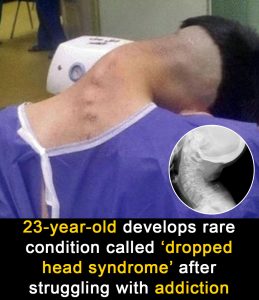Addiction can have a devastating effect on both the mind and body. Its consequences can vary depending on many factors, with the type of substance used playing a major role in the health outcomes experienced by individuals. While the world is well aware of the destructive power of drugs, sometimes the reality hits harder when one encounters a case so rare and alarming that it forces us to confront the profound damage that substance abuse can inflict. One such case involves a 23-year-old man from Iran whose addiction led him to develop a shocking and unusual condition—one that left him unable to hold his head up.

This young man, according to medical reports, was a frequent user of amphetamines, particularly a substance commonly referred to as “speed.” Over time, the drug’s effect on his behavior and posture took a severe toll. Doctors observed that his chin had begun to collapse into his chest for extended periods. Eventually, this posture became permanent, leaving him with a dramatic bend in his neck—a condition now identified as “fixed kyphotic neck position.” This deformity caused his head to drop forward unnaturally, leading to significant discomfort and mobility issues.
Further examination revealed that his substance abuse extended beyond amphetamines. He also regularly consumed heroin and opium. The accumulation of drug use and the lifestyle that accompanied it significantly altered his physical posture. Physicians were perplexed at first, trying to determine whether his condition was purely the result of drug use or if there could have been an underlying, undiagnosed health issue. However, all indications pointed toward addiction being the catalyst for his physical transformation.
Dr. Majid Rezvan, who co-authored the medical case study, offered important insights into the cause of the young man’s condition. He explained that the development of this extreme cervical kyphosis—an excessive forward curvature of the spine in the neck area—was indirectly related to the drug use. “The drug does not directly affect the musculoskeletal system,” Dr. Rezvan noted. “What we discovered was that prolonged drug use led to the individual staying in a fixed posture for hours, even days, at a time. Over the course of months, this sedentary behavior caused structural changes to the spine.” These postural habits eventually led to kyphoscoliosis, a condition that involves both kyphosis and scoliosis—an abnormal lateral curve of the spine.
This condition, commonly referred to as “dropped head syndrome” or “floppy head syndrome,” is more often seen in individuals with neuromuscular disorders, such as motor neuron disease or certain forms of muscular dystrophy. However, in rare cases, it may develop in drug users whose neck muscles weaken from disuse and poor posture. What made this case particularly tragic is that the patient was not born with any muscular or skeletal defects. His condition developed solely from the consequences of substance abuse and the lifestyle that followed.
For the past 15 months, the man had reportedly suffered from chronic neck pain and paresthesia—a condition characterized by tingling, numbness, and a pins-and-needles sensation in his arms. These symptoms not only caused physical discomfort but also hindered his ability to function normally in daily life. No treatment seemed to bring relief, and his quality of life deteriorated rapidly. When a CT scan was conducted, doctors found that his cervical spine was severely deformed. Interestingly, while the man was under general anesthesia during surgery preparation, some temporary improvement in his neck positioning was observed. This suggested that muscle tension and pain contributed to his inability to lift his head in a conscious state.
Despite the grave nature of his condition, there was a glimmer of hope. Surgery was performed to correct the structural deformity in his cervical spine. Surgeons intervened to realign and stabilize the bones, and the operation was deemed a success. Remarkably, the young man was able to walk unassisted the very next day, aided by the use of a rigid neck collar that supported his head and neck. His mobility and posture showed immediate signs of improvement—a hopeful sign for both doctors and the patient himself.
Post-surgery, the medical team emphasized the urgent need for the man to enter a comprehensive rehabilitation program. This wasn’t just for physical therapy, but more importantly, to treat his drug addiction. Without tackling the root cause, there would be a significant risk of relapse and the possible return of similar health complications. Addiction, after all, is not just a battle of willpower—it is a chronic condition that demands medical, psychological, and social support to overcome.
This story serves as a sobering reminder of the unpredictable and often irreversible effects of substance abuse. While many are aware of the risks associated with drug use—such as dependency, overdose, and organ damage—few imagine that something as simple and vital as holding up one’s head could be compromised. It sheds light on how addiction doesn’t just impact the brain but can physically reshape the body in painful and debilitating ways.
If you or someone you know is dealing with addiction, it is crucial to seek help before the consequences become too severe. Substance abuse is a disease that thrives in silence, stigma, and neglect. But there are resources available, and recovery is always possible with the right support and treatment. For those in need of assistance, various organizations offer guidance, therapy, and medical care for individuals battling drug and alcohol addiction. Visit reputable addiction support websites or consult with a healthcare provider to begin the journey to recovery. Getting help today could prevent a tragic situation tomorrow.





